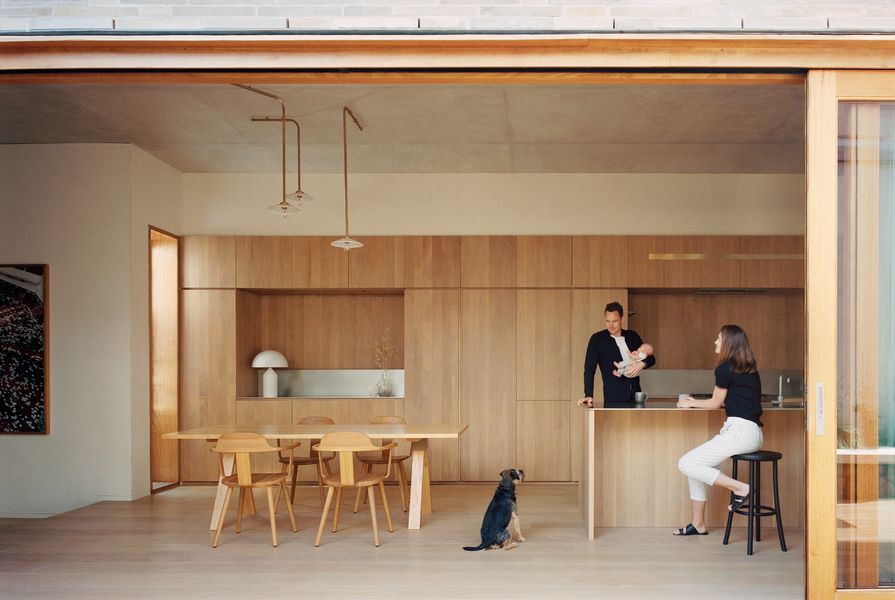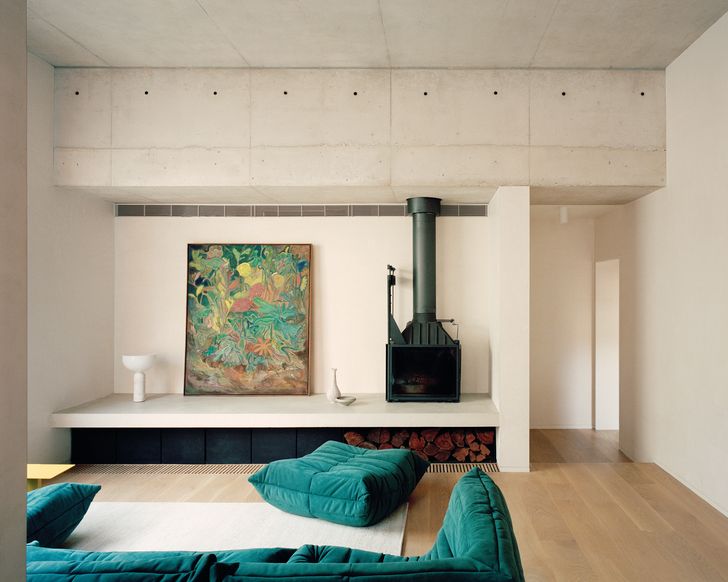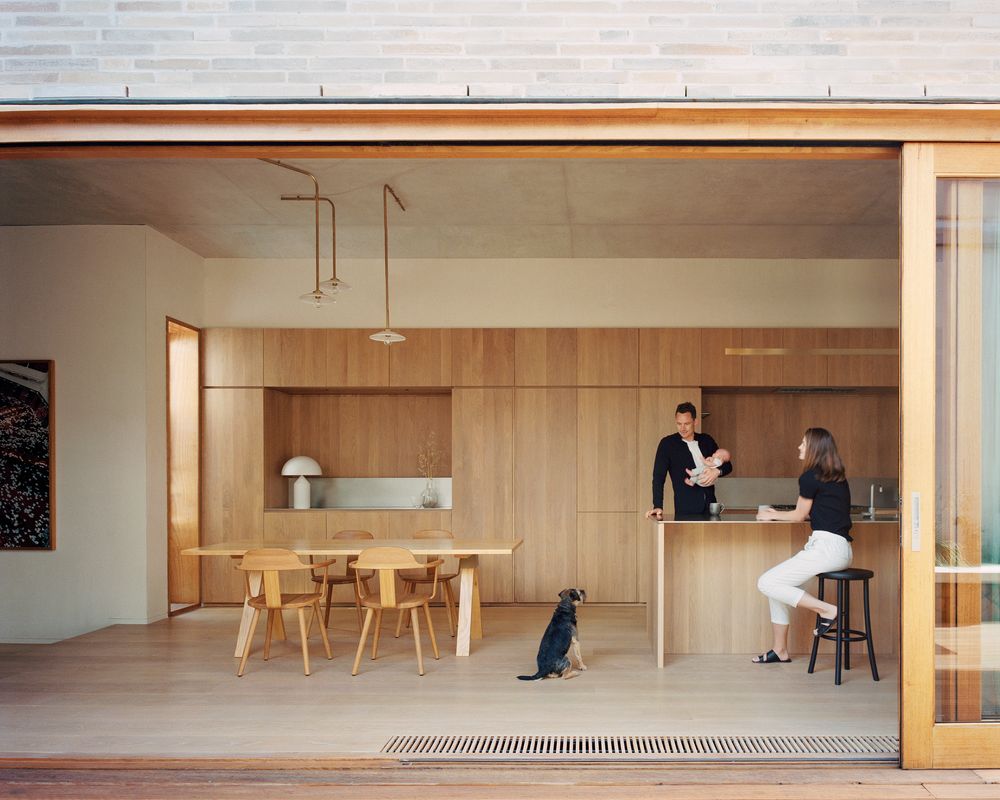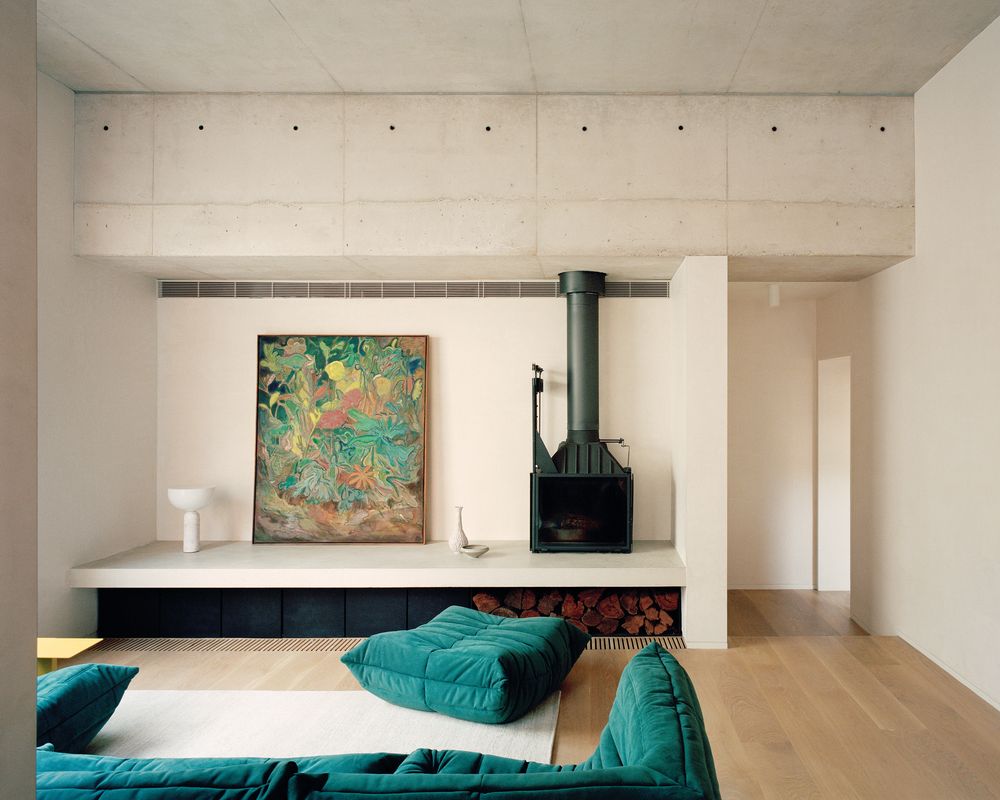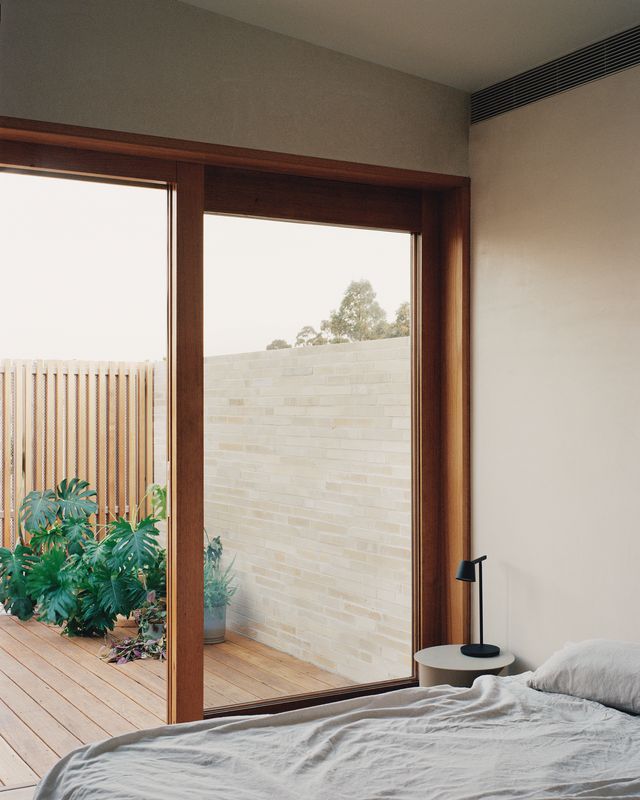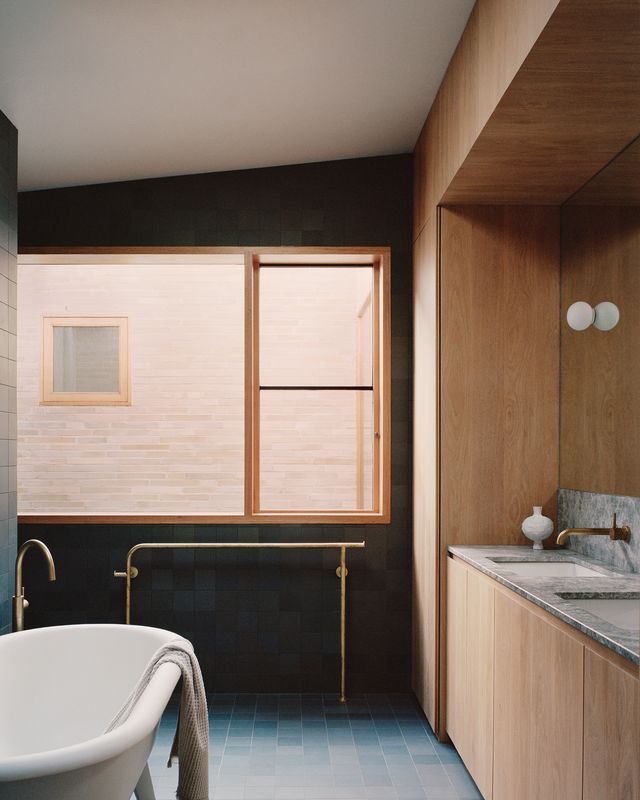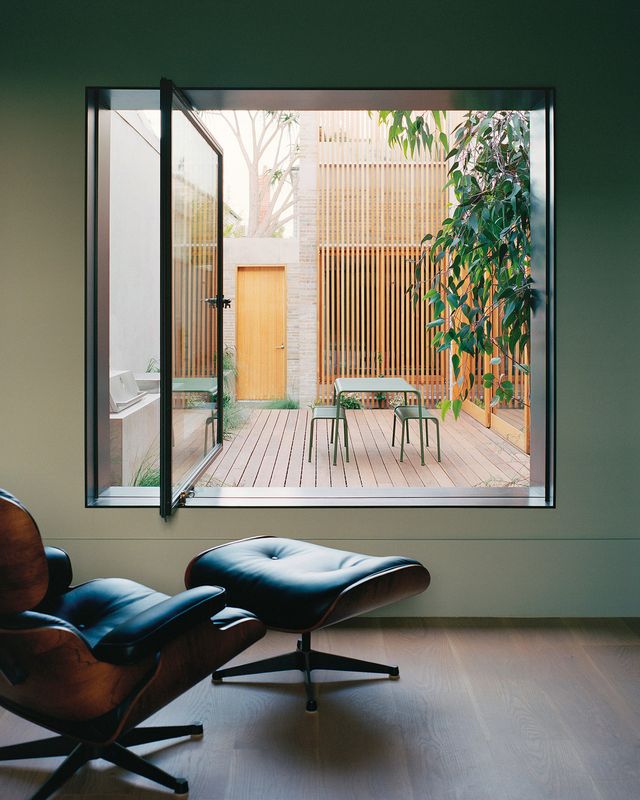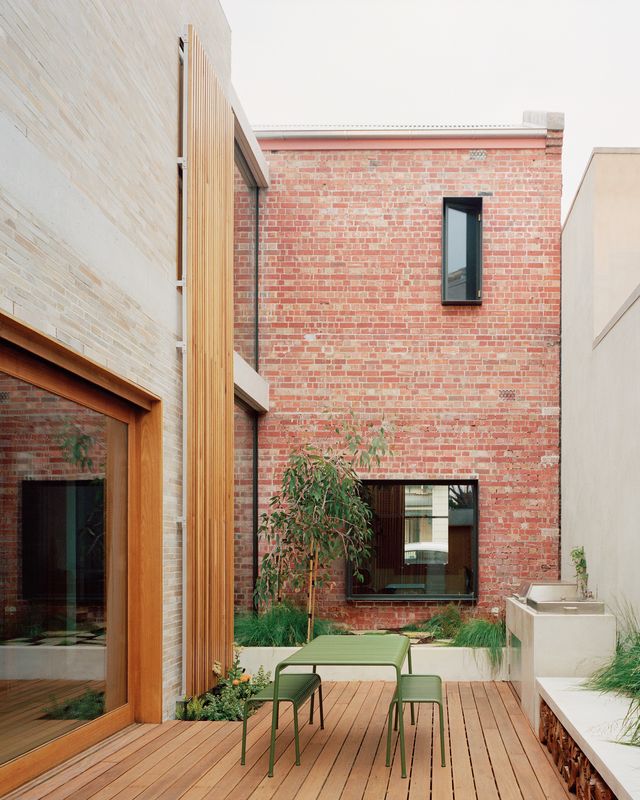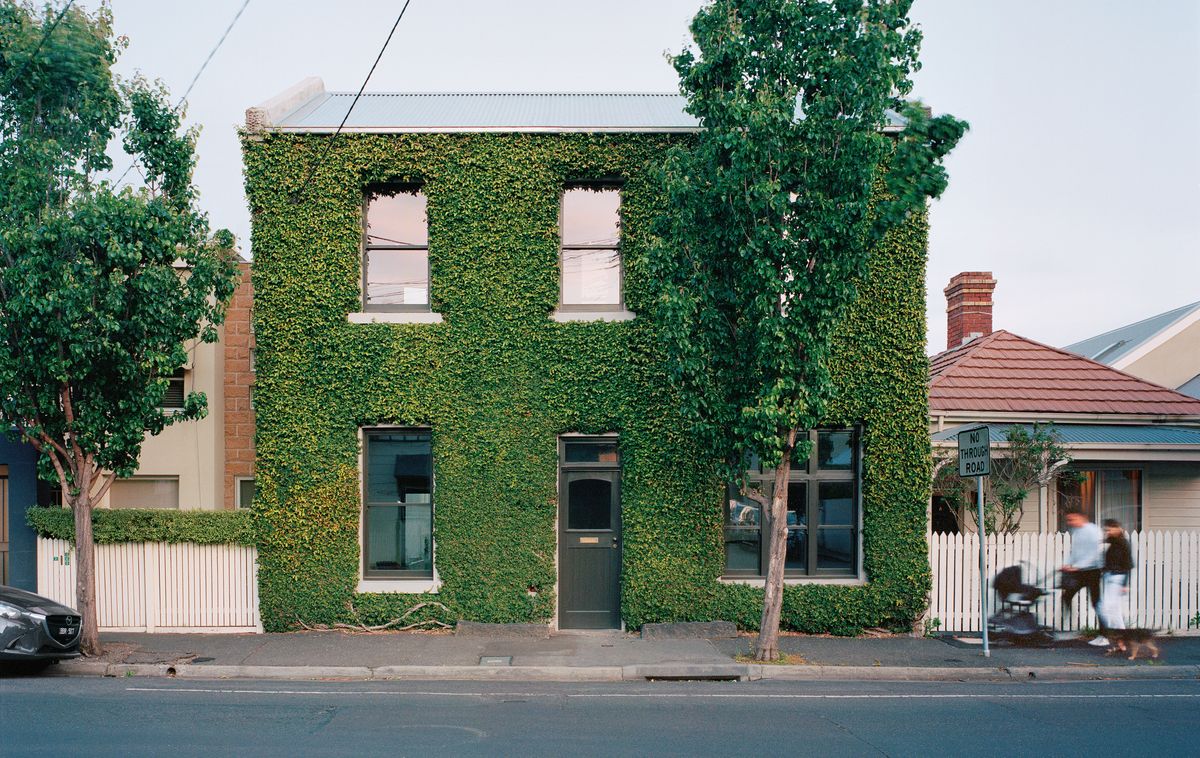According to architect Alex Lake, his design practice Therefore is not aiming to change the world but rather trying to do some basic things very well. This is the message Alex imparts during our discussion one sunny spring day in Melbourne’s inner-east. Judging by the surroundings, Alex and his small team are succeeding at this humble aspiration.
Richmond House is a measured performance from a studio that cut its teeth in the world of hospitality, and it represents only the third house completed by Therefore. As the hospitality industry reels from the economic impact of COVID-19, diversification into residential architecture is certainly appealing to a design practice – and the lessons learnt in one sector can’t help but translate effectively in the hands of skilled practitioners. No time is wasted in a life of design.
Multiple levels gently evoke the Victorian terrace house while retaining a modern feel. Artwork: Seth Diego Birchall
Image: Rory Gardiner
The character of this house shows a restraint that is rare in residential architecture and it became clear to me, in the short time I spent inside the house, that the drive to refine fundamental design tasks is a core philosophy for Therefore. Alex describes the design as a careful dance between wilful design intention and circumstantial acceptance. The design seems to step lightly through the project’s constraints: from the response to planning controls and the solution for the heritage frontage of the original house to the light-touch handling of passive solar orientation and cross-flow ventilation, the resolution feels comfortable, even natural. Certainly effortless.
It is no secret that, in design, an apparent effortlessness requires a mammoth effort, and the response to the brief has been exacting. This house suits its owners – a young family – very well, and they are growing into the design as the garden takes hold.
The heritage remnant of the original house, which was reportedly a tinsmith’s commercial residence, is one room deep while the rear, in the timeworn tradition of the inner-city terrace, had seen a collection of lean-tos accrete over time. These additions were removed and the bones of the old front rooms over two levels were stripped back and exposed to the ample light.
Laid by hand, this brick wall will one day support foliage similar to that of the heritage frontage.
Image: Rory Gardiner
There are no ceiling roses or elaborate cornices here: The previously adulterated interiors have been laid bare, illuminated by their generous front windows. The windows in particular seem to have preoccupied the designers; the street-facing ground-floor window to the north is a Victorian standard, while its partner to the south is a larger Edwardian shopfront glazing assembly – a hint of the building’s former life.
In the original, ground-floor room at the north-west corner of the house, a new steel pivot window has been installed in the brickwork, opening to a new courtyard. This window contrasts with the original Victorian sash window in materiality, proportion and function, drawing the distinction between original and new with absolute clarity.
A steel pivot window forms a contemporary link with the new courtyard space.
Image: Rory Gardiner
The house is woven around three courtyards, a large one facing north and two smaller ones positioned on the southern boundary, with landscape design by Therefore’s studio neighbour in Fitzroy, Acre. In the largest courtyard, greenery is slowly engulfing the Roman brick laid painstakingly by hand in a randomised bond. The aspiration for the vegetation in the courtyards is that over time it will suffuse the architecture just as the vine has subsumed the street facade.
In a light-handed gesture to the Victorian heritage of the original building, the rooms in the new addition are delineated by subtle level changes rather than defining walls. The result is a chain of sun-filled rooms that wrap around the courtyard, with plentiful glazing facing north to embrace the courtyard. The kitchen, dining room and living room step down the site, terminating with a single garage along the rear boundary. In this way the style of living is wholeheartedly open-plan and modern, with just a referential nod toward the house’s past.
A first-floor bedroom opens onto a split-level terrace with a rooftop vegetable garden.
Image: Rory Gardiner
A suspended concrete slab supports the first floor, its soffit exposed in the ground-floor kitchen, dining room and living room. Bedrooms on the first floor connect to an east-facing, split-level terrace, with a relaxing space and a rooftop vegetable garden. This is not a large house, but each space has a generosity that is enhanced by access to sunlight and views of the sky.
Richmond House is an excellent example of what can be achieved when a design team attempts to resolve simple matters well, rather than express something explicitly form-driven or contemporary. It is certainly one antidote to the relentless drive for originality and currency that is weighing down much contemporary design. I hope Therefore keeps doing houses: they have a knack for it.
Products and materials
- Roofing
- Revolution Roofing True Oak Deep roof sheeting; Lysaght Trimdek
- External walls
- Krause Bricks Emperor bricks in ‘Ghost’; Adbri Masonry concrete blocks; Hanson Australia in-situ concrete
- Windows and doors
- Carison Bros. timber windows and doors; Amore Engineering steel windows in Porter’s Paints ‘River Stone’ paint finish
- Flooring
- Solid American oak floorboards; Mutina Mews Chevron tiles in ‘Ink’
- Lighting
- Muller van Severen Ceiling Lamps; Oluce Atollo 237 lamp and Flos Mini Glo-Ball from Euroluce; Archier Capital pendant; New Works Kizu table lamp in ‘White Marble’ and Lantern floor lamp; Muuto Tip table lamp
- Kitchen
- Astra Walker Icon tapware; Franke Bolero undermount sink; Miele integrated fridge–freezer and dishwasher; Ilve oven and cooktop; Whispair Monte Carlo rangehood; solid American oak joinery; stainless steel benchtops and splashback
- Bathroom
- Custom brass towel rail by Jason Blake; Mutina Mews Industrial tiles in ‘Fog’ and ‘Lead’; Agape Ottocento bath from Artedomus; Falper Lavamani wall-hung basin from Rogerseller
- Heating and cooling
- Cheminees Philippe wood heater
- External elements
- Beefeater barbecue; Fenwesco Custom Parilla barbecue; Eco Outdoor Endicott crazy paving
- Other
- Hay Palissade table and bench from Cult; Mattiazzi Zampa stools; Studio Henry Wilson A-Joint brass and American oak table; Stolab Sture armchair from Thonet; Ligne Roset Togo sofa from Domo; Halcyon Lake rugs; Gubi Pacha lounge chair; Herman Miller Eames lounge chair
Credits
- Project
- Richmond House by Therefore Studio
- Architect
- Therefore
Melbourne, Vic, Australia
- Project Team
- Alex Lake, Mark Allen, Ben Shackleton
- Consultants
-
Builder
Locbuild
Landscape design Acre
Landscaping Urban Horticultural Solutions
Stylist Jessica Lillico
- Aboriginal Nation
- Richmond House is built on the land of the Wurundjeri people of the Kulin nation.
- Site Details
-
Location
Richmond,
Melbourne,
Vic,
Australia
Site type Urban
Site area 247 m2
Building area 181 m2
- Project Details
-
Completion date
2020
Design, documentation 15 months
Construction 18 months
Category Residential
Type Alts and adds
Source
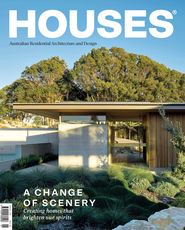
Project
Published online: 17 Sep 2021
Words:
Marcus Baumgart
Images:
Rory Gardiner
Issue
Houses, February 2021

